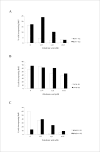Estradiol impairs the antiproliferative and proapoptotic effect of Zoledronic acid in hormone sensitive breast cancer cells in vitro
- PMID: 28945801
- PMCID: PMC5612728
- DOI: 10.1371/journal.pone.0185566
Estradiol impairs the antiproliferative and proapoptotic effect of Zoledronic acid in hormone sensitive breast cancer cells in vitro
Abstract
Background: Zoledronic acid (ZA) has antiresorptive effects and protects from bone metastasis in women with early breast cancer. In addition, in postmenopausal women with endocrine responsive breast cancer ZA prolongs DFS. The exact mechanism is still unclear. We have therefore investigated the effect of increasing concentrations of ZA in breast cancer cell lines in the absence or presence of estradiol to mimic the hormonal environment in vitro.
Materials and methods: Using assays for cell proliferation (EZ4U, BrdU) and cell death (Annexin/PI), we have analyzed the dose-dependent antiproliferative and pro-apoptotic effects of ZA in two hormone sensitive cell lines (MCF-7 and T47D) and a hormone insensitive, triple negative cell line (MDA-MB-231) in the presence of 0, 1 and 10 nM estradiol.
Results: In the absence of estradiol, ZA exerts dose-dependent antiproliferative and pro-apoptotic antitumor effects in both, hormone sensitive (MCF-7, T47D) and -insensitive (MDA-MB-231) breast cancer cell lines (p<0.0001). In the presence of estradiol, the antitumoral effect of ZA was significantly decreased only in the hormone sensitive MCF-7 and T47D cell lines (p = 0.0008 and p = 0.0008, respectively).
Conclusion: We have demonstrated that estradiol impairs the antiproliferative and proapoptotic effect of ZA in hormone sensitive, but not in hormone insensitive breast cancer cell lines. Our findings provide a possible explanation for the differential effect of ZA on DFS in pre- and postmenopausal patients with hormone sensitive early breast cancer, which has been demonstrated clinically. We further hypothesize that endocrine insensitive tumors such as triple negative breast cancer (TNBC) should benefit from ZA irrespective of their menopausal status.
Conflict of interest statement
Figures






Similar articles
-
The miR-21/PTEN/Akt signaling pathway is involved in the anti-tumoral effects of zoledronic acid in human breast cancer cell lines.Naunyn Schmiedebergs Arch Pharmacol. 2016 May;389(5):529-38. doi: 10.1007/s00210-016-1224-8. Epub 2016 Feb 24. Naunyn Schmiedebergs Arch Pharmacol. 2016. PMID: 26905520
-
Synergistic suppression of human breast cancer cells by combination of plumbagin and zoledronic acid In vitro.Acta Pharmacol Sin. 2015 Sep;36(9):1085-98. doi: 10.1038/aps.2015.42. Epub 2015 Aug 3. Acta Pharmacol Sin. 2015. PMID: 26235741 Free PMC article.
-
Cisplatin in combination with zoledronic acid: a synergistic effect in triple-negative breast cancer cell lines.Int J Oncol. 2013 Apr;42(4):1263-70. doi: 10.3892/ijo.2013.1809. Epub 2013 Feb 6. Int J Oncol. 2013. PMID: 23403907
-
The role of zoledronic acid in the adjuvant treatment of breast cancer: current perspectives.Expert Opin Pharmacother. 2010 Nov;11(16):2715-25. doi: 10.1517/14656566.2010.523699. Expert Opin Pharmacother. 2010. PMID: 20977404 Review.
-
Zoledronic acid effectiveness against breast cancer metastases - a role for estrogen in the microenvironment?Breast Cancer Res. 2012 Sep 21;14(5):213. doi: 10.1186/bcr3223. Breast Cancer Res. 2012. PMID: 23014660 Free PMC article. Review.
Cited by
-
Select HDAC Inhibitors Enhance Osteolysis and Bone Metastasis Outgrowth but Can Be Mitigated With Bisphosphonate Therapy.JBMR Plus. 2023 Jan 25;7(3):e10694. doi: 10.1002/jbm4.10694. eCollection 2023 Mar. JBMR Plus. 2023. PMID: 36936362 Free PMC article.
-
Single-cell immunoblotting resolves estrogen receptor-α isoforms in breast cancer.PLoS One. 2021 Jul 27;16(7):e0254783. doi: 10.1371/journal.pone.0254783. eCollection 2021. PLoS One. 2021. PMID: 34314438 Free PMC article.
-
Targeting claudin-4 enhances chemosensitivity in breast cancer.Cancer Sci. 2020 May;111(5):1840-1850. doi: 10.1111/cas.14361. Epub 2020 Mar 18. Cancer Sci. 2020. PMID: 32086991 Free PMC article.
References
-
- Early Breast Cancer Trialists’ Collaborative Group. Effects of chemotherapy and hormonal therapy for early breast cancer on recurrence and 15-year survival: an overview of the randomised trials. Lancet 2005;365:1687–1717. doi: 10.1016/S0140-6736(05)66544-0 - DOI - PubMed
-
- Clezardin P. Potential anticancer properties of bisphosphonates: insights from preclinical studies. Anticancer Agents Med Chem 2012;12:102–113. - PubMed
-
- Hadji P, Aapro MS, Body JJ, Bundred NJ, Brufsky A, Coleman RE, et al. Management of aromatase inhibitor-associated bone loss in postmenopausal women with breast cancer: practical guidance for prevention and treatment. Ann Oncol 2011;22:2546–2555. doi: 10.1093/annonc/mdr017 - DOI - PubMed
-
- Brufsky AM, Harker WG, Beck JT, Bosserman L, Vogel C, Seidler C, et al. Final 5-year results of z-fast trial: adjuvant ZA maintains bone mass in postmenopausal breast cancer patients receiving letrozole. Cancer 2012;118:1192–1201. doi: 10.1002/cncr.26313 - DOI - PubMed
-
- Coleman R, de Boer R, Eidtmann H, Llombart A, Davidson N, Neven P, et al. ZA (zoledronate) for postmenopausal women with early breast cancer receiving adjuvant letrozole (zo-fast study): final 60-month results. Ann Oncol 2013;24:398–405. doi: 10.1093/annonc/mds277 - DOI - PubMed
MeSH terms
Substances
LinkOut - more resources
Full Text Sources
Other Literature Sources
Medical
Research Materials
Miscellaneous

